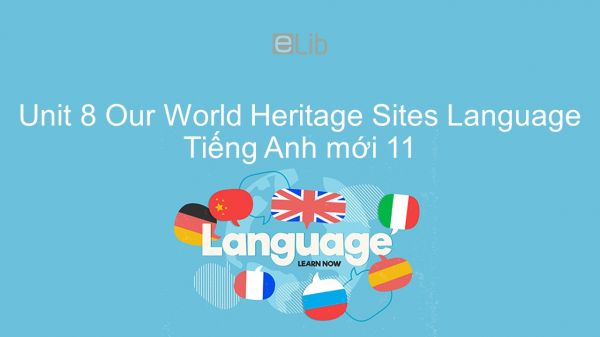Unit 8 lớp 11: Our World Heritage Sites - Language
Bài học Unit 8 Tiếng Anh lớp 11 mới phần Language giới thiệu các em một số từ vựng, cách phát âm đặc biệt và các điểm ngữ pháp mới liên quan đến chủ đề bài học "Những di sản thế giới". Mời các em cùng tham khảo!
Mục lục nội dung

Unit 8 lớp 11: Our World Heritage Sites - Language
1. Vocabulary
1.1. Task 1 Unit 8 lớp 11
Fill the blanks with the right form of the words from the box. (Điền vào chỗ trống bằng dạng đúng của các từ cho sẵn trong khung.)

Guide to answer
1. These historic buildings are an important part of Ha Noi’s heritage and should be preserved
(Những tòa nhà lịch sử này là một phần quan trọng của di sản Hà Nội và cần được bảo tồn.)
2. During the different dynasties, the Thang Long Imperial Citadel was expanded.
(Trong suốt các triều đại khác nhau, Hoàng Thành Thăng Long được mở rộng.)
3. The archaeological excavations that led to the discovery of the ancient city lasted several years.
(Các cuộc khai quật khảo cổ đã dẫn tới việc khám phá thành phố cổ này kéo dài vài năm.)
4. A lot of ancient houses in Hoi An remain intact even after several hundred years.
(Rất nhiều ngôi nhà cổ ở Hội An vẫn còn nguyên vẹn ngay cả sau vài trăm năm.)
5. A lot of relics from ancient times are on display at the national heritage museum.
(Rất nhiều di vật từ thời cổ đại được trưng bày tại bảo tàng di sản quốc gia.)
6. The old houses have been pulled down in order to build a modern residential complex.
(Các ngôi nhà cũ đã được phá bỏ để xây dựng một khu dân cư hiện đại.)
1.2. Task 2 Unit 8 lớp 11
Use the correct form of the word in brackets to complete each sentence. (Sử dạng đúng của từ cho sẵn trong ngoặc kép để hoàn thành các câu dưới đây.)
Guide to answer
1. At the Central Sector of the Imperial Citadel of Thang Long, visitors can see the archaeological site at 18 Hoang Dieu Street and several famous monuments. (archaeology)
(Tại khu vực Trung tâm của Hoàng thành Thăng Long, du khách có thể xem khu khảo cổ học tại số 18 Hoàng Diệu và một số di tích nổi tiếng.)
2. Ha Long Bay was recognised as a World Natural Heritage Site for its natural beauty and geological value in 1994 and 2000 respectively. (nature)
(Vịnh Hạ Long được công nhận là di sản thiên nhiên thế giới vì vẻ đẹp tự nhiên và giá trị địa chất vào năm 1994 và 2000.)
3. In December 1993, UNESCO recognised the Complex of Hue Monuments as a World Cultural Heritage Site – the first site in Viet Nam to be added to the World Heritage list. (culture)
(Tháng 12 năm 1993, UNESCO công nhận Tổ hợp di tích văn hoá Huế là di sản văn hoá thế giới - khu vực đầu tiên ở Việt Nam được thêm vào danh sách Di sản Thế giới.)
4. The tour of the cave and grotto system is the main attraction for tourists in Phong Nha - Ke Bang National Park. (attract)
(Chuyến du lịch tới hang động và hệ thống hang động là điểm thu hút chính cho khách du lịch trong Vườn Quốc gia Phong Nha - Kẻ Bàng.)
5. What is special about Hoi An Ancient Town is that it is in a good state of preservation. (preserve)
(Điều đặc biệt về Phố cổ Hội An là ở trạng thái bảo tồn tốt.)
2. Pronunciation
Choices questions (Câu hỏi lựa chọn)
2.1. Task 1 Unit 8 lớp 11
Listen to these exchanges and pay attention to the intonation pattern of the question. (Nghe những mẩu hội thoại dưới đây, chú ý đến kiểu ngữ điệu của các câu hỏi.)
Click to listen
1. A: Is My Son Sanctuary a natural or cultural world heritage site?
B: It’s a cultural heritage site.
2. A: Shall we go to the Citadel of the Ho Dynasty or do you want to see another site?
B: Let’s go to the Citadel.
3. A: Which world heritage site would you like to visit? Ha Long Bay, Phong Nha - Ke Bang National Park, or Trang An Scenic Landscape Complex?
B: I’d like to visit Ha Long Bay.
4. A: When is the best time to visit the Complex of Hue Monuments? In April or in June?
B: In April.
5. A: Do you want to visit the ancient town or the modern complex?
B: I want to see the ancient town.
Tạm dịch:
1. A: Khu bảo tồn Mỹ Sơn là di sản văn hoá thế giới tự nhiên hay văn hoá?
B: Đó là một di sản văn hoá.
2. A: Chúng ta sẽ đi đến Thành nhà Hồ hay là bạn muốn xem một cảnh đẹp khác?
B: Hãy đi đến Citadel.
3. A: Bạn muốn ghé thăm di sản thế giới nào? Vịnh Hạ Long, vườn quốc gia Phong Nha - Kẻ Bàng, hoặc khu cảnh quan Trảng An?
B: Tôi muốn thăm Vịnh Hạ Long.
4. A: Khi nào là thời gian tốt nhất để đến thăm Khu di tích Tổ hợp Huế? Vào tháng 4 hoặc tháng 6?
B: Vào tháng Tư.
5. A: Bạn có muốn ghé thăm khu phố cổ hoặc khu phức hợp hiện đại?
B: Tôi muốn nhìn thấy phố cổ.
2.2. Task 2 Unit 8 lớp 11
Now listen to 1 again and practise saying these exchanges. (Hãy nghe bài tập 1 một lần nữa và tập nói lại các mẩu hội thoại này.)
Click to listen
1. A: Is My Son Sanctuary a natural ↗ or cultural world heritage site ↘?
B: It’s a cultural heritage site.
2. A: Shall we go to the Citadel of the Ho Dynasty ↗ or do you want to see another site ↘?
B: Let’s go to the Citadel.
3. A: Which world heritage site would you like to visit? Ha Long Bay ↗ , Phong Nha - Ke Bang National Park ↗ , or Trang An Scenic Landscape Complex ↘?
B: I’d like to visit Ha Long Bay.
4. A: When is the best time to visit the Complex of Hue Monuments? In April ↗ or in June ↘?
B: In April.
5. A: Do you want to visit the ancient town ↗ or the modern complex ↘?
B: I want to see the ancient town.
3. Grammar
Participle and to-infinitive clauses (Mệnh đề phân từ và mệnh đề động từ nguyên mẫu có to)
3.1. Task 1 Unit 8 lớp 11
Underline the correct word or phrase in each sentence (Gạch dưới từ / cụm từ đúng trong mỗi câu dưới đây.)
Guide to answer
1. Have you visited the pagodas (to lie / lying / lain) on Tran Phu Street in Hoi An?
(Bạn đã đến thăm những ngôi chùa nằm trên phố Trần Phú ở Hội An chưa?)
2. Irresponsible tourists damaged the archaeological site and some of the relics (to date / dating / to be dated) back to the last ruling dynasty.
(Khách du lịch không được làm hỏng khu khảo cổ học và một số di tích có niên đại từ triều đại cầm quyền cuối cùng.)
3. The ancient houses (to destroy / destroying / destroyed) by the fire are now under reconstruction.
(Những ngôi nhà cổ bị phá hủy bởi đám cháy đang được tái cấu trúc.)
4. Most tourists like buying clothes, lanterns, and other handicrafts (to make / making / made) by local craftsmen in Hoi An.
(Hầu hết khách du lịch thích mua quần áo, đèn lồng, và các nghề thủ công được làm từ thợ thủ công địa phương ở Hội An.)
5. The only thing (to see / seeing / sees) at the Citadel of the Ho Dynasty is the stone walls.
(Điều duy nhất để nhìn thấy ở thành nhà Hồ là những bức tường đá.)
6. The Complex of Hue Monuments was the first site in Viet Nam (to be recognised / be recognising / recognises) as a World Heritage Site by UNESCO.
(Khu di tích Huế là di tích lịch sử đầu tiên ở Việt Nam được UNESCO công nhận là di sản thế giới.)
3.2. Task 2 Unit 8 lớp 11
Rewrite the sentences replacing the relative clauses with participle or to-infinitive clauses.(Viết lại những câu dưới đây, thay thế mệnh đề quan hệ bằng phân từ động từ nguyên mẫu có TO.)
1. Some of the relics that were found at the archaeological site of the Central Sector of the Imperial Citadel of Thang Long belong to the Ly Dynasty.
2. The Japanese Bridge that was built in the early 1600s became a main tourist attraction in Hoi An.
3. Tourists should avoid purchasing unusual relics that were illegally removed from protected heritage sites.
4. He was the last emperor who ruled both parts of the empire.
5. We visited an ancient house that overlooks the Thu Bon River in Hoi An.
6. Trang An Scenic Landscape Complex is the 8th World Heritage Site in Viet Nam that has been recognised by UNESCO.
Guide to answer
1. Some of the relics found at the archaeological site of the Central Sector of the Imperial Citadel of Thang Long belong to the Ly Dynasty.
(Một số di tích đã được tìm thấy tại khu khảo cổ học thuộc Khu vực Trung tâm của Hoàng Thành Thăng Long thuộc thời Lý.)
2. The Japanese Bridge built in the early 1600s became a main tourist attraction in Hoi An.
(Cầu Nhật Bản được xây dựng vào đầu những năm 1600 đã trở thành điểm thu hút khách du lịch chính tại Hội An.)
3. Tourists should avoid purchasing unusual relics illegally removed from protected heritage sites.
(Khách du lịch nên tránh mua những di vật bất thường đã bị vận chuyển trái phép khỏi các di sản được bảo tồn.)
4. He was the last emperor to rule both parts of the empire.
(Ông là vị hoàng đế cuối cùng cai trị cả hai phần của đế chế.)
5. We visited an ancient house overlooking the Thu Bon River in Hoi An.
(Chúng tôi thăm một ngôi nhà cổ kính nhìn ra sông Thu Bồn ở Hội An.)
6. Trang An Scenic Landscape Complex is the 8th World Heritage Site in Viet Nam to be recognised by UNESCO.
(Khu cảnh quan Tràng An là di sản thế giới thứ 8 tại Việt Nam đã được UNESCO công nhận.)
4. Practice Task 1
Mark the letter A, B, C, or D to indicate the word(s) OPPOSITE in meaning to the underlined word(s) in each of the following questions.
Question 1: The major stone sections of the Citadel of the Ho Dynasty remain intact thanks to the unique construction techniques.:
A. special B. common C. excellent D. ancient
Question 2: The Imperial Citadel of Thang Long was first built during the Ly Dynasty and then expanded by subsequent dynasties
A. following B. successive C. preceding D. next
Question 3: Visitors with more abundant travel budgets can enjoy the comfort of five-star hotels and luxury cruise ships.
A. huge B. plentiful C. mean D. tight
5. Practice Task 2
Mark the letter A, B, C, or D to indicate the word whose underlined part differs from the other three in pronunciation in each of the following questions.
Question 1: A. scholar B. technique C. archaeology D. achievement
Question 2: A. ancient B. conchern C. assochiate D. spechial
Question 3: A. itinerary B. abundant C. elegance D. landscape
Question 4: A. tomb B. dome C. mosaic D. poetic
Question 5: A. numerous B. luxury C. perfume D. monument
Để rèn luyện kĩ năng phát âm và nhấn âm mới đối với các từ khác nhau, mời các em đến với phần trắc nghiệm Unit 8 Language Tiếng Anh 11 mới sau đây và cùng luyện tập.
7. Conclusion
Kết thúc bài học Unit 8 Tiếng Anh mới Lớp 11 – Language, các em cần nắm:
- Các từ vựng trong phần Getting Started
- Ngữ điệu trong câu hỏi lựa chọn
- Mệnh đề phân từ và mệnh đề động từ nguyên mẫu có to
+ Mệnh đề phân từ:
Mệnh đề quan hệ chứa các đại từ quan hệ làm chủ từ who, which, that có thể được rút gọn thành cụm hiện tại phân từ (V-ing) hoặc quá khứ phân từ (V3/ed).
Ex: The couple who live next door to me are professors.
=> The couple living next door to me are professors.
+ Mệnh đề động từ nguyên mẫu có to:
Mệnh đề quan hệ được rút thành cụm động từ nguyên mẫu (To-infinitive) khi trước đại từ quan hệ có các cụm từ: the first, the second, the last, the only hoặc hình thức so sánh bậc nhất.
Ex: He was the best player that got the prize.
=> He was the best played to get the prize.
Tham khảo thêm
- doc Unit 8 lớp 11: Our World Heritage Sites - Getting Started
- doc Unit 8 lớp 11: Our World Heritage Sites - Reading
- doc Unit 8 lớp 11: Our World Heritage Sites - Speaking
- doc Unit 8 lớp 11: Our World Heritage Sites - Listening
- doc Unit 8 lớp 11: Our World Heritage Sites - Writing
- doc Unit 8 lớp 11: Our World Heritage Sites - Communication and Culture
- doc Unit 8 lớp 11: Our World Heritage Sites - Looking Back
- doc Unit 8 lớp 11: Our World Heritage Sites - Project




